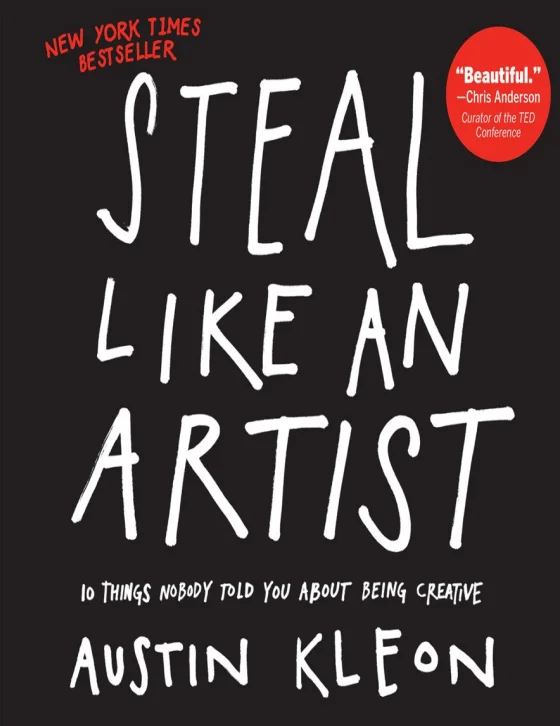
Nothing is original. The writer Jonathan Lethem has said that when people call something ‘original,’ nine out of ten times they just don’t know the references or the original sources involved. What a good artist understands is that nothing comes from nowhere. All creative work builds on what came before. Every new idea is just a mashup or a remix of one or more previous ideas. You are, in fact, a mashup of what you choose to let into your life. You are the sum of your influences.
Short Summary (500 words):
“Steal Like an Artist” is Austin Kleon’s compact but powerful manifesto on creativity in the digital age, published in 2012. Based on a talk that went viral, this illustrated guide presents ten transformative principles for discovering your artistic path through a mindset of “constructive theft.”
Kleon’s central premise is both provocative and liberating: “Nothing is original.” Drawing on examples from music, literature, and visual arts, he dismantles the myth of originality by showing how all creative work builds on what came before. The book’s title itself is inspired by a quote attributed to Picasso: “Art is theft.” Rather than seeing this as discouraging, Kleon presents it as freedom from the impossible burden of originating something from nothing.
The first principle, “Steal like an artist,” clarifies that creative theft isn’t about plagiarism or imitation but about finding influences you love, studying them deeply, and transforming their work through your unique perspective. Kleon distinguishes between “good theft” (honoring, studying, crediting, transforming) and “bad theft” (degrading, skimming, plagiarizing, imitating).
In “Don’t wait until you know who you are to get started,” Kleon tackles the paralyzing quest for artistic identity, arguing that you discover who you are by creating, not before creating. He famously advises, “Start copying… Copy, copy, copy. At the end of the copy, you will find yourself.”
The book’s visual aesthetic mirrors its content – combining handwritten notes, simple line drawings, and found images into what Kleon calls a “mixtape” approach to writing. This design reinforces his message about creative recombination.
Kleon offers practical advice on developing creative habits: “Write the book you want to read” encourages creating what genuinely interests you rather than chasing market trends. “Use your hands” advocates for stepping away from digital tools to engage physically with your work, while “Side projects and hobbies are important” celebrates the cross-pollination that occurs through diverse interests.
In “Geography is no longer our master,” Kleon acknowledges the internet’s transformation of creative communities while still advocating for balancing digital connectivity with private workspace – his concept of “scenius” (communal genius) versus solitude.
The book takes a holistic approach to creative life. “Be nice. The world is a small town” emphasizes professional generosity, sharing, and building community. “Be boring” offers counterintuitive advice about establishing stable routines and taking care of practical matters to support creative flourishing.
Throughout, Kleon peppers the text with quotes and examples from creative giants who have “stolen” successfully – T.S. Eliot, David Bowie, Jonathan Lethem, and many others – while maintaining his conversational, encouraging tone.
The final principle, “Creativity is subtraction,” encapsulates Kleon’s minimalist aesthetic by emphasizing the importance of knowing what to leave out. He quotes sculptor Hans Hoffman: “The ability to simplify means to eliminate the unnecessary so that the necessary may speak.”
In just over 100 pages, Kleon delivers an accessible philosophy of creativity that resonates with beginners and established artists alike. The book’s enduring appeal stems from its permission-giving nature – freeing readers from the pressure of originality while providing practical steps to find their authentic voice through thoughtful “stealing.”